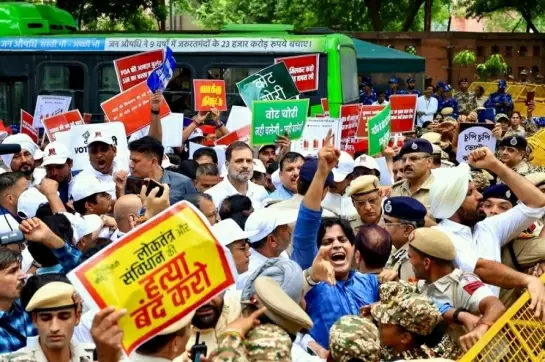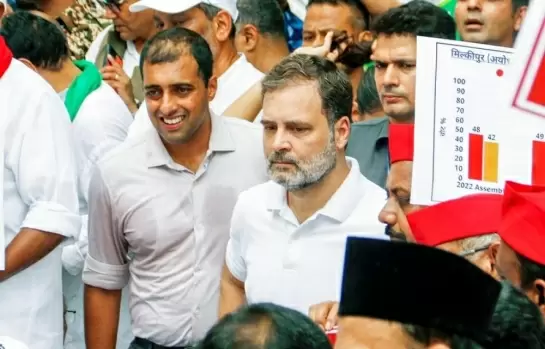Market seeks effective transmission, higher cuts from RBI to tackle slowdown
06-June-2019
Market experts were bullish on the RBI decision to cut the repo rate to 5.75% by 25 bps and change in its stance to being accommodative at a time of slowdown in demand and consumption, but they were equally vocal about higher and more such cuts, effective transmission rates of such reductions for any tangible results to check slide in growth.
The Sensex (BSE) has taken a cue from this and is down 1.29% at 39,571.60 at 3 p.m. Some had expected rate cuts to the extent of 35-50 bps.
Naveen Kulkarni, Head of Research, Reliance Securities, said while the rate cut of 25 basis points was in line with his expectation, concerns over growth and challenges on liquidity continue to linger. The market is not necessarily cheering the rate cut as it had already factored it, and that something more was expected.
Joseph Thomas, Head Research-Emkay Wealth Management, said the RBI policy announcement is "exactly on the same lines as expected by most of the market participants". The repo rate cut of 0.25 per cent and the change of stance from neutral to accommodative is key to supporting the sagging economic growth. The policy also has broad indications of more action on the liquidity front from the RBI in the coming days. This also confirms the commitment of the Central bank to better transmission of the rate cut effects through liquidity.
Yesterday India Ratings and Research had said any rate cut is unlikely to stimulate demand in the near term due to the absence of quick resonance in the financial market.
Kotak Securities notes the change in stance and the tone of the policy. The tone of the policy and the guidance seem to suggest that the RBI is adequately worried about growth even as it is comfortable on the evolution of the inflation trajectory, it said.
The tone of the policy was dovish with RBI highlighting "there is scope for the MPC to accommodate growth concerns by supporting efforts to boost aggregate demand, and in particular, reinvigorate private investment activity, while remaining consistent with its flexible inflation targeting mandate", it added.
There are some risks to inflation as food inflation has been increasing. Clarity on its trajectory and extent of upside in headline inflation should be available towards end 1HFY20/early 2HFY20. Scope for further rate cuts (beyond August) will depend on the extent of further growth slowdown and downside to inflation from RBI's estimated levels, the brokerage said.
Deepthi Mathew, Economist, Geojit Financial Services, said " Now the ball is in Government's court, as what all measures the new Finance Minister will announce in her Budget to revive the economy. The market has even expected a rate cut by even 50 basis points. The Central bank has also revised the CPI inflation to 3.0-3.1 per cent from the earlier 2.9-3 per cent for H1FY20. The rising food prices are one of the major factors for the upward revisions in the CPI inflation rate. Food and beverages registered a growth rate of 1.38 per cent in April, with vegetables prices registering a growth rate of 2.87 per cent in April from a negative growth rate of 1.49 per cent in March."
He is also of the view that with regulations reinstating home buyers' confidence in the segment, markets, however, have witnessed recovery in sales in 2018. Further, in the January-March quarter of 2019, sales grew by 28% as compared to the corresponding quarter in 2018. But commensurate transmission in interest rates will further boost residential sales momentum in 2019. Stronger implementation and continuity of reforms under the second term of the current government will uplift home buyers' sentiment.
Mahesh Singhi, Founder & MD, Singhi Advisors said: "The MPC's decision is akin to extending the much-needed monetary policy support to the government's proposed fiscal measures to spur growth and investment cycles. Also welcome is the apex bank's decision to change its stance from neutral to accommodative. Both measures will help improve the liquidity situation in the economy as well as support economic growth. With inflation cycle appearng to peak, the MPC has enough headroom for further rate reduction. MPC's decision is also in line with the Central bank's stated policy of supporting economic growth without losing sight of its inflation trajectory".
Engineering & Export Promotion Council said the key lies in substantive transmission of the rate cut by banks.
EEPC India Chairman Ravi Sehgal said, "Exporters are facing slowdown in global trade and thus would need an urgent supporting hand. Despite the third consecutive rate cut by the RBI, the transmission by banks has been rather low, reflecting more of a tokenism than a substantive reduction in cost of lending."
Exports could not sustain the March 2019 growth of 11.8 per cent in April, when the overall export expansion was by a mere 0.6 per cent, making urgent measures imperative.
Sujan Hajra, Chief Economist and Executive Director, Anand Rathi Shares & Stock Brokers, said: "The real concern is lack of transmission of rate cuts into effective lending rates. Liquidity conditions also remain tight for a large part of the corporate sector. Effective transmission and adequate liquidity remain key challenges."
Amit Gupta, Co-Founder, and CEO, TradingBells said: "RBI changed its stance to accommodative and a possibility of further rate cuts this year remains open (we can expect a further rate cut of 50 to 75 basis points in 2019). Real estate, NBFC, banking, and auto sectors would be the key beneficiaries of this rate cut where a temporary uptick can be seen in many stocks, but quality stocks will continue to outperform".
Umesh Revankar, MD and CEO - Shriram Transport Finance Ltd, said: "The transmission of the previous rate cuts had been very discouraging at only 5-10 bps. As the monsoon predication is very positive, we expected RBI to take a bolder step and do 50 bps rates cut, which would have given a clear signal to India Inc to push for growth and take investment decisions thereby maintaining the capex cycle".
Because of higher interest rates, the consumer spending has been very weak. "We urge RBI to open up funding to retail NBFCs through banks that will stimulate spending," Revankar said. IANS
‘Vote Chori’ Row: INDIA Bloc MPs to March From Parliament to Election Commission
Kulgam Encounter: Two Army Soldiers Martyred as Operation Enters Ninth Day
India Sends Strong Message to Trump: Foreign Policy Won’t Be Dictated
Hortus Malabaricus Garden Revives 17th-Century Botanical Legacy in Kerala
Cop Killer Shot Dead: Manikandan Killed in Encounter in Tiruppur









